key battery FORD E SERIES 2017 4.G Owners Manual
[x] Cancel search | Manufacturer: FORD, Model Year: 2017, Model line: E SERIES, Model: FORD E SERIES 2017 4.GPages: 318, PDF Size: 6.21 MB
Page 39 of 318
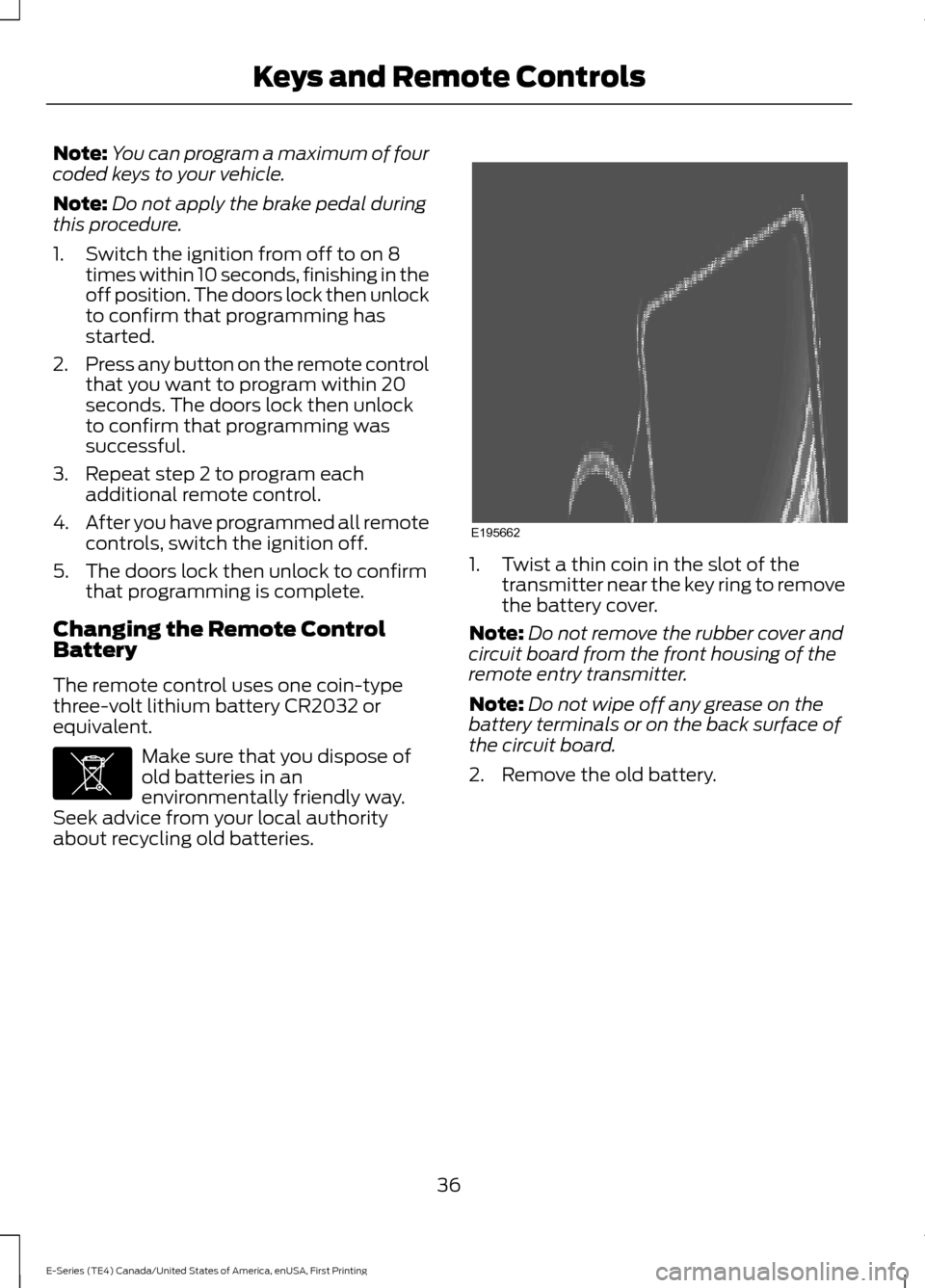
Note:
You can program a maximum of four
coded keys to your vehicle.
Note: Do not apply the brake pedal during
this procedure.
1. Switch the ignition from off to on 8 times within 10 seconds, finishing in the
off position. The doors lock then unlock
to confirm that programming has
started.
2. Press any button on the remote control
that you want to program within 20
seconds. The doors lock then unlock
to confirm that programming was
successful.
3. Repeat step 2 to program each additional remote control.
4. After you have programmed all remote
controls, switch the ignition off.
5. The doors lock then unlock to confirm that programming is complete.
Changing the Remote Control
Battery
The remote control uses one coin-type
three-volt lithium battery CR2032 or
equivalent. Make sure that you dispose of
old batteries in an
environmentally friendly way.
Seek advice from your local authority
about recycling old batteries. 1. Twist a thin coin in the slot of the
transmitter near the key ring to remove
the battery cover.
Note: Do not remove the rubber cover and
circuit board from the front housing of the
remote entry transmitter.
Note: Do not wipe off any grease on the
battery terminals or on the back surface of
the circuit board.
2. Remove the old battery.
36
E-Series (TE4) Canada/United States of America, enUSA, First Printing Keys and Remote ControlsE107998 E195662
Page 40 of 318
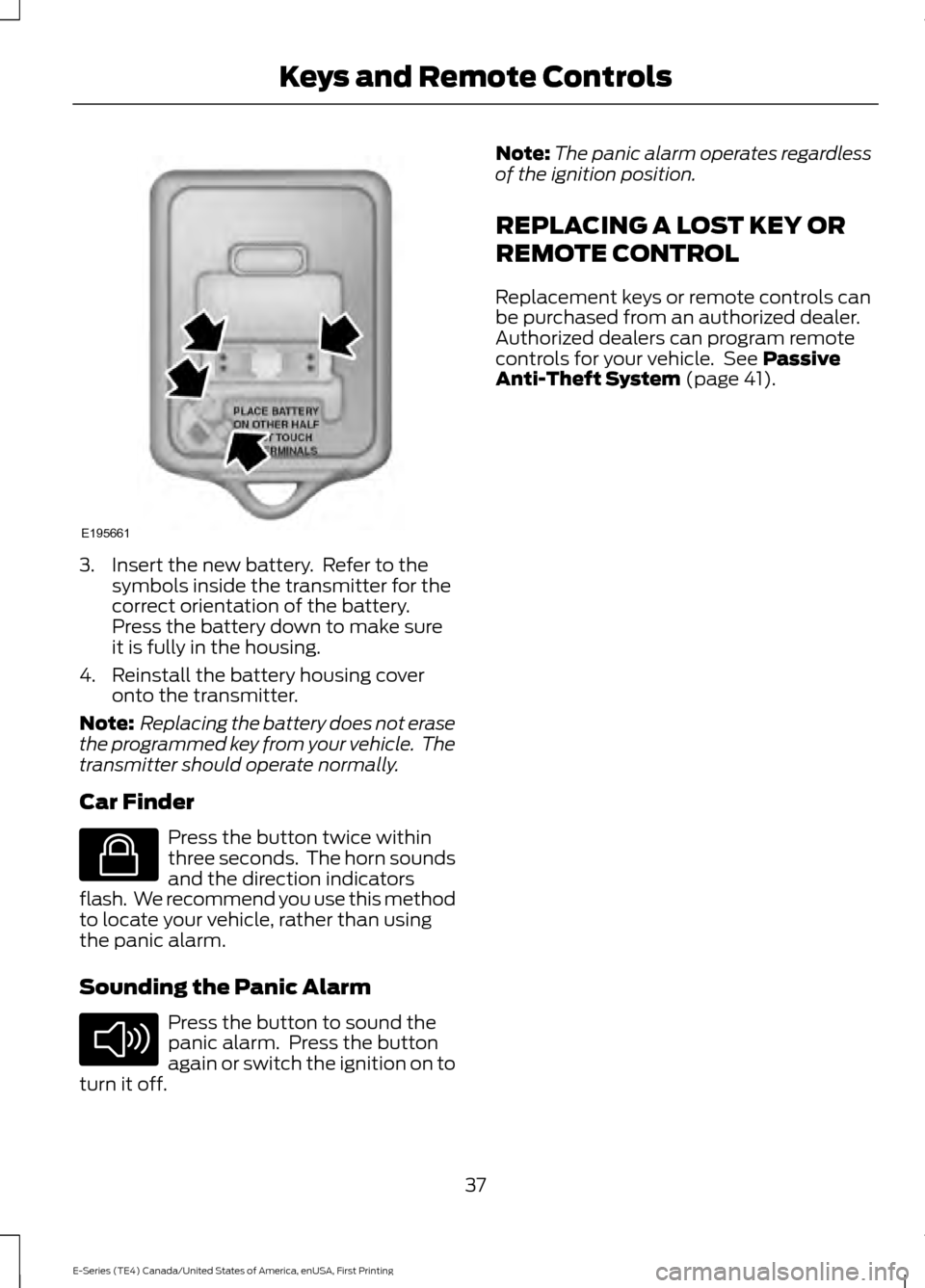
3. Insert the new battery. Refer to the
symbols inside the transmitter for the
correct orientation of the battery.
Press the battery down to make sure
it is fully in the housing.
4. Reinstall the battery housing cover onto the transmitter.
Note: Replacing the battery does not erase
the programmed key from your vehicle. The
transmitter should operate normally.
Car Finder Press the button twice within
three seconds. The horn sounds
and the direction indicators
flash. We recommend you use this method
to locate your vehicle, rather than using
the panic alarm.
Sounding the Panic Alarm Press the button to sound the
panic alarm. Press the button
again or switch the ignition on to
turn it off. Note:
The panic alarm operates regardless
of the ignition position.
REPLACING A LOST KEY OR
REMOTE CONTROL
Replacement keys or remote controls can
be purchased from an authorized dealer.
Authorized dealers can program remote
controls for your vehicle. See Passive
Anti-Theft System (page 41).
37
E-Series (TE4) Canada/United States of America, enUSA, First Printing Keys and Remote ControlsE195661 E138623 E138624
Page 75 of 318
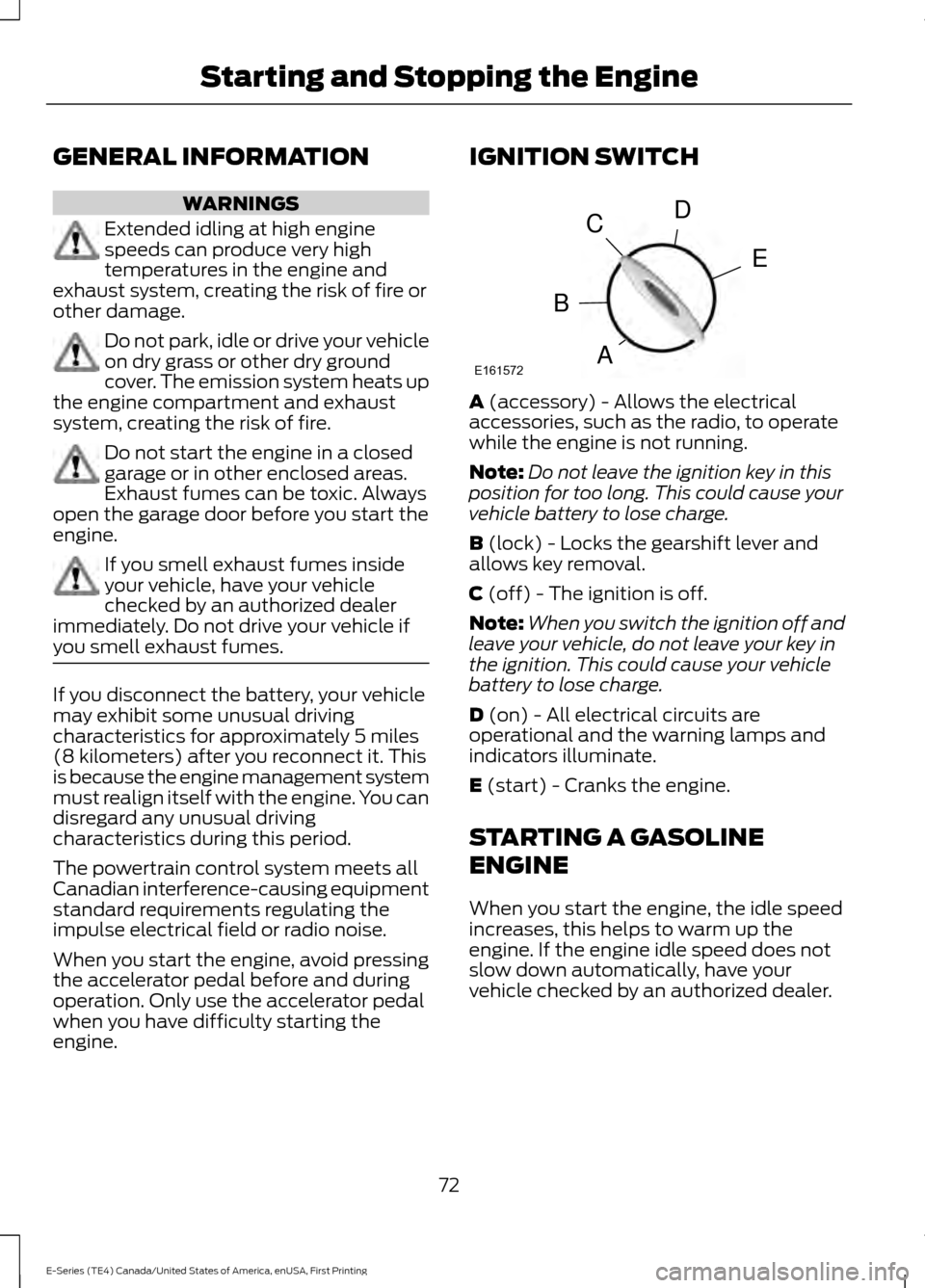
GENERAL INFORMATION
WARNINGS
Extended idling at high engine
speeds can produce very high
temperatures in the engine and
exhaust system, creating the risk of fire or
other damage. Do not park, idle or drive your vehicle
on dry grass or other dry ground
cover. The emission system heats up
the engine compartment and exhaust
system, creating the risk of fire. Do not start the engine in a closed
garage or in other enclosed areas.
Exhaust fumes can be toxic. Always
open the garage door before you start the
engine. If you smell exhaust fumes inside
your vehicle, have your vehicle
checked by an authorized dealer
immediately. Do not drive your vehicle if
you smell exhaust fumes. If you disconnect the battery, your vehicle
may exhibit some unusual driving
characteristics for approximately 5 miles
(8 kilometers) after you reconnect it. This
is because the engine management system
must realign itself with the engine. You can
disregard any unusual driving
characteristics during this period.
The powertrain control system meets all
Canadian interference-causing equipment
standard requirements regulating the
impulse electrical field or radio noise.
When you start the engine, avoid pressing
the accelerator pedal before and during
operation. Only use the accelerator pedal
when you have difficulty starting the
engine. IGNITION SWITCH
A (accessory) - Allows the electrical
accessories, such as the radio, to operate
while the engine is not running.
Note: Do not leave the ignition key in this
position for too long. This could cause your
vehicle battery to lose charge.
B
(lock) - Locks the gearshift lever and
allows key removal.
C
(off) - The ignition is off.
Note: When you switch the ignition off and
leave your vehicle, do not leave your key in
the ignition. This could cause your vehicle
battery to lose charge.
D
(on) - All electrical circuits are
operational and the warning lamps and
indicators illuminate.
E
(start) - Cranks the engine.
STARTING A GASOLINE
ENGINE
When you start the engine, the idle speed
increases, this helps to warm up the
engine. If the engine idle speed does not
slow down automatically, have your
vehicle checked by an authorized dealer.
72
E-Series (TE4) Canada/United States of America, enUSA, First Printing Starting and Stopping the EngineE161572
D
E
C
B
A
Page 85 of 318
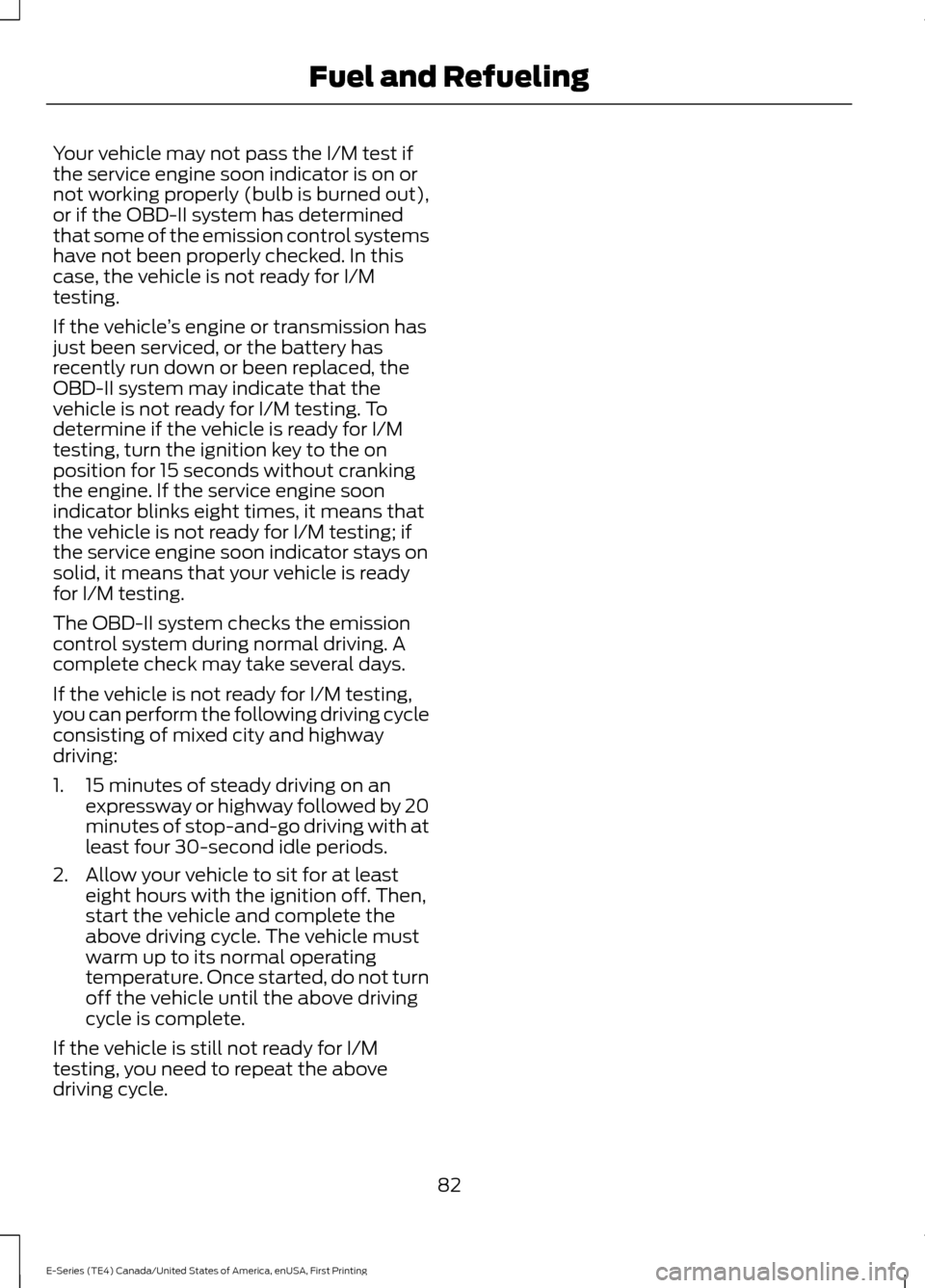
Your vehicle may not pass the I/M test if
the service engine soon indicator is on or
not working properly (bulb is burned out),
or if the OBD-II system has determined
that some of the emission control systems
have not been properly checked. In this
case, the vehicle is not ready for I/M
testing.
If the vehicle
’s engine or transmission has
just been serviced, or the battery has
recently run down or been replaced, the
OBD-II system may indicate that the
vehicle is not ready for I/M testing. To
determine if the vehicle is ready for I/M
testing, turn the ignition key to the on
position for 15 seconds without cranking
the engine. If the service engine soon
indicator blinks eight times, it means that
the vehicle is not ready for I/M testing; if
the service engine soon indicator stays on
solid, it means that your vehicle is ready
for I/M testing.
The OBD-II system checks the emission
control system during normal driving. A
complete check may take several days.
If the vehicle is not ready for I/M testing,
you can perform the following driving cycle
consisting of mixed city and highway
driving:
1. 15 minutes of steady driving on an expressway or highway followed by 20
minutes of stop-and-go driving with at
least four 30-second idle periods.
2. Allow your vehicle to sit for at least eight hours with the ignition off. Then,
start the vehicle and complete the
above driving cycle. The vehicle must
warm up to its normal operating
temperature. Once started, do not turn
off the vehicle until the above driving
cycle is complete.
If the vehicle is still not ready for I/M
testing, you need to repeat the above
driving cycle.
82
E-Series (TE4) Canada/United States of America, enUSA, First Printing Fuel and Refueling
Page 116 of 318
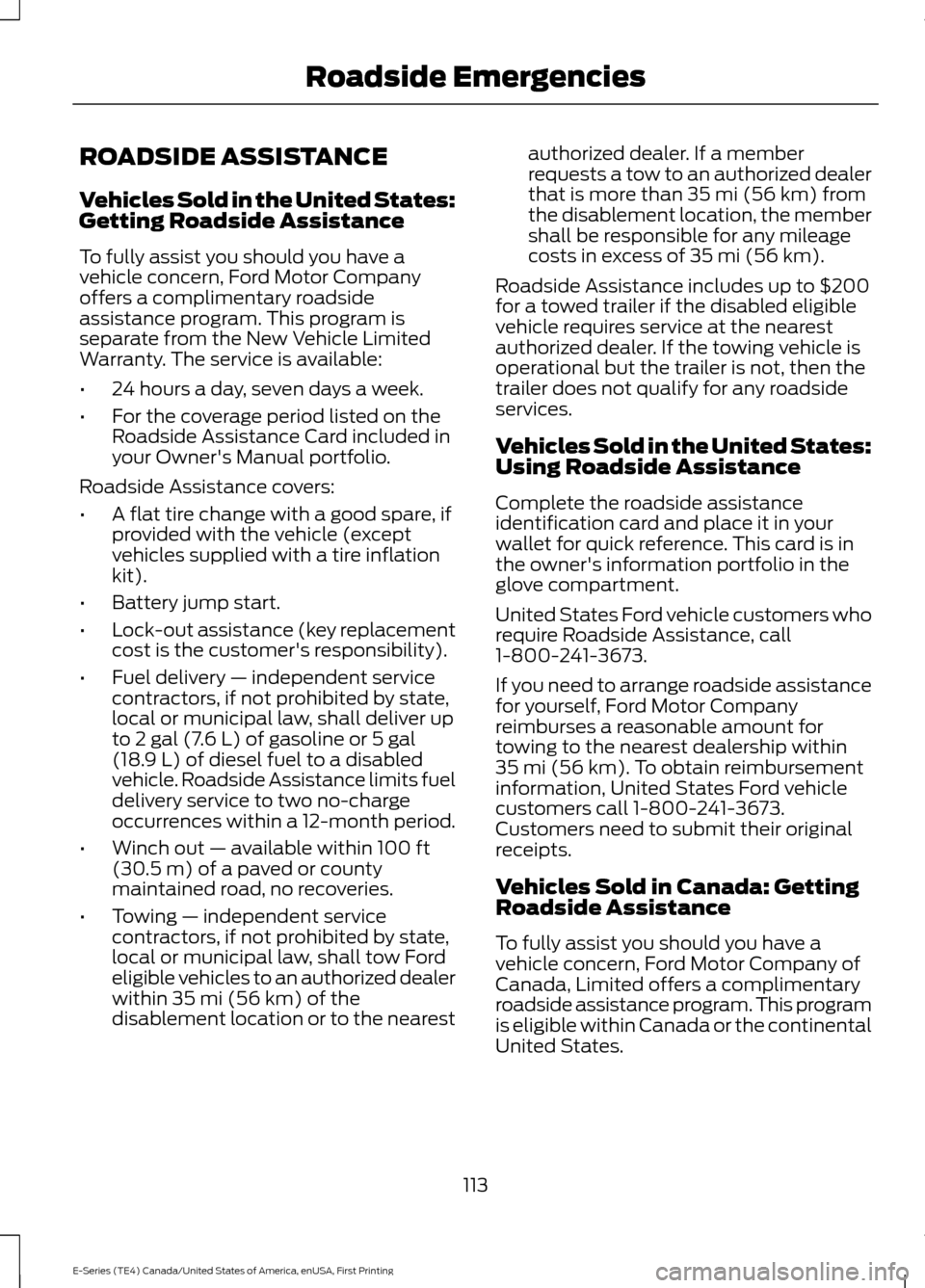
ROADSIDE ASSISTANCE
Vehicles Sold in the United States:
Getting Roadside Assistance
To fully assist you should you have a
vehicle concern, Ford Motor Company
offers a complimentary roadside
assistance program. This program is
separate from the New Vehicle Limited
Warranty. The service is available:
•
24 hours a day, seven days a week.
• For the coverage period listed on the
Roadside Assistance Card included in
your Owner's Manual portfolio.
Roadside Assistance covers:
• A flat tire change with a good spare, if
provided with the vehicle (except
vehicles supplied with a tire inflation
kit).
• Battery jump start.
• Lock-out assistance (key replacement
cost is the customer's responsibility).
• Fuel delivery — independent service
contractors, if not prohibited by state,
local or municipal law, shall deliver up
to 2 gal (7.6 L) of gasoline or 5 gal
(18.9 L) of diesel fuel to a disabled
vehicle. Roadside Assistance limits fuel
delivery service to two no-charge
occurrences within a 12-month period.
• Winch out — available within
100 ft
(30.5 m) of a paved or county
maintained road, no recoveries.
• Towing — independent service
contractors, if not prohibited by state,
local or municipal law, shall tow Ford
eligible vehicles to an authorized dealer
within
35 mi (56 km) of the
disablement location or to the nearest authorized dealer. If a member
requests a tow to an authorized dealer
that is more than
35 mi (56 km) from
the disablement location, the member
shall be responsible for any mileage
costs in excess of
35 mi (56 km).
Roadside Assistance includes up to $200
for a towed trailer if the disabled eligible
vehicle requires service at the nearest
authorized dealer. If the towing vehicle is
operational but the trailer is not, then the
trailer does not qualify for any roadside
services.
Vehicles Sold in the United States:
Using Roadside Assistance
Complete the roadside assistance
identification card and place it in your
wallet for quick reference. This card is in
the owner's information portfolio in the
glove compartment.
United States Ford vehicle customers who
require Roadside Assistance, call
1-800-241-3673.
If you need to arrange roadside assistance
for yourself, Ford Motor Company
reimburses a reasonable amount for
towing to the nearest dealership within
35 mi (56 km)
. To obtain reimbursement
information, United States Ford vehicle
customers call 1-800-241-3673.
Customers need to submit their original
receipts.
Vehicles Sold in Canada: Getting
Roadside Assistance
To fully assist you should you have a
vehicle concern, Ford Motor Company of
Canada, Limited offers a complimentary
roadside assistance program. This program
is eligible within Canada or the continental
United States.
113
E-Series (TE4) Canada/United States of America, enUSA, First Printing Roadside Emergencies
Page 117 of 318
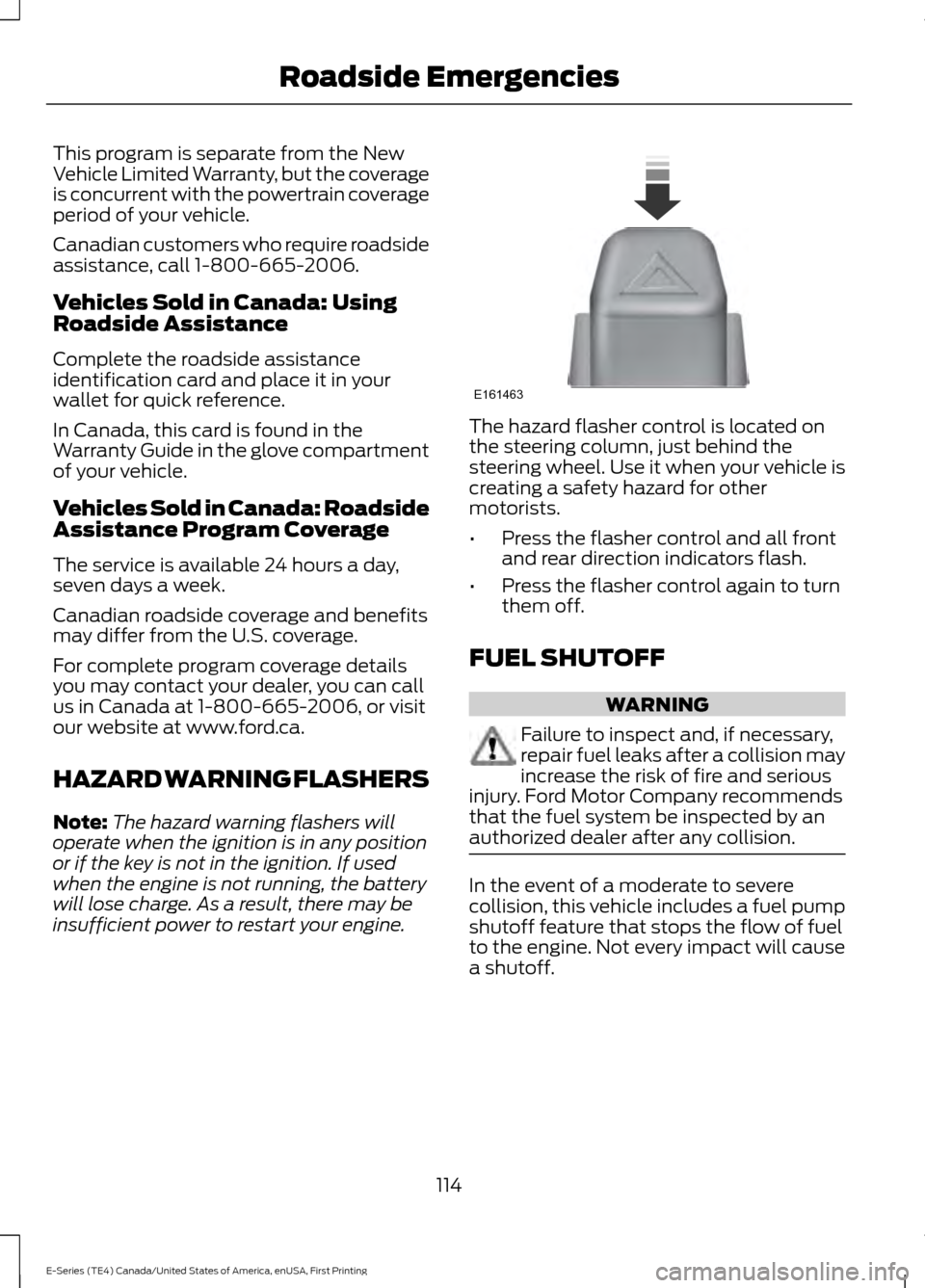
This program is separate from the New
Vehicle Limited Warranty, but the coverage
is concurrent with the powertrain coverage
period of your vehicle.
Canadian customers who require roadside
assistance, call 1-800-665-2006.
Vehicles Sold in Canada: Using
Roadside Assistance
Complete the roadside assistance
identification card and place it in your
wallet for quick reference.
In Canada, this card is found in the
Warranty Guide in the glove compartment
of your vehicle.
Vehicles Sold in Canada: Roadside
Assistance Program Coverage
The service is available 24 hours a day,
seven days a week.
Canadian roadside coverage and benefits
may differ from the U.S. coverage.
For complete program coverage details
you may contact your dealer, you can call
us in Canada at 1-800-665-2006, or visit
our website at www.ford.ca.
HAZARD WARNING FLASHERS
Note:
The hazard warning flashers will
operate when the ignition is in any position
or if the key is not in the ignition. If used
when the engine is not running, the battery
will lose charge. As a result, there may be
insufficient power to restart your engine. The hazard flasher control is located on
the steering column, just behind the
steering wheel. Use it when your vehicle is
creating a safety hazard for other
motorists.
•
Press the flasher control and all front
and rear direction indicators flash.
• Press the flasher control again to turn
them off.
FUEL SHUTOFF WARNING
Failure to inspect and, if necessary,
repair fuel leaks after a collision may
increase the risk of fire and serious
injury. Ford Motor Company recommends
that the fuel system be inspected by an
authorized dealer after any collision. In the event of a moderate to severe
collision, this vehicle includes a fuel pump
shutoff feature that stops the flow of fuel
to the engine. Not every impact will cause
a shutoff.
114
E-Series (TE4) Canada/United States of America, enUSA, First Printing Roadside EmergenciesE161463
Page 118 of 318
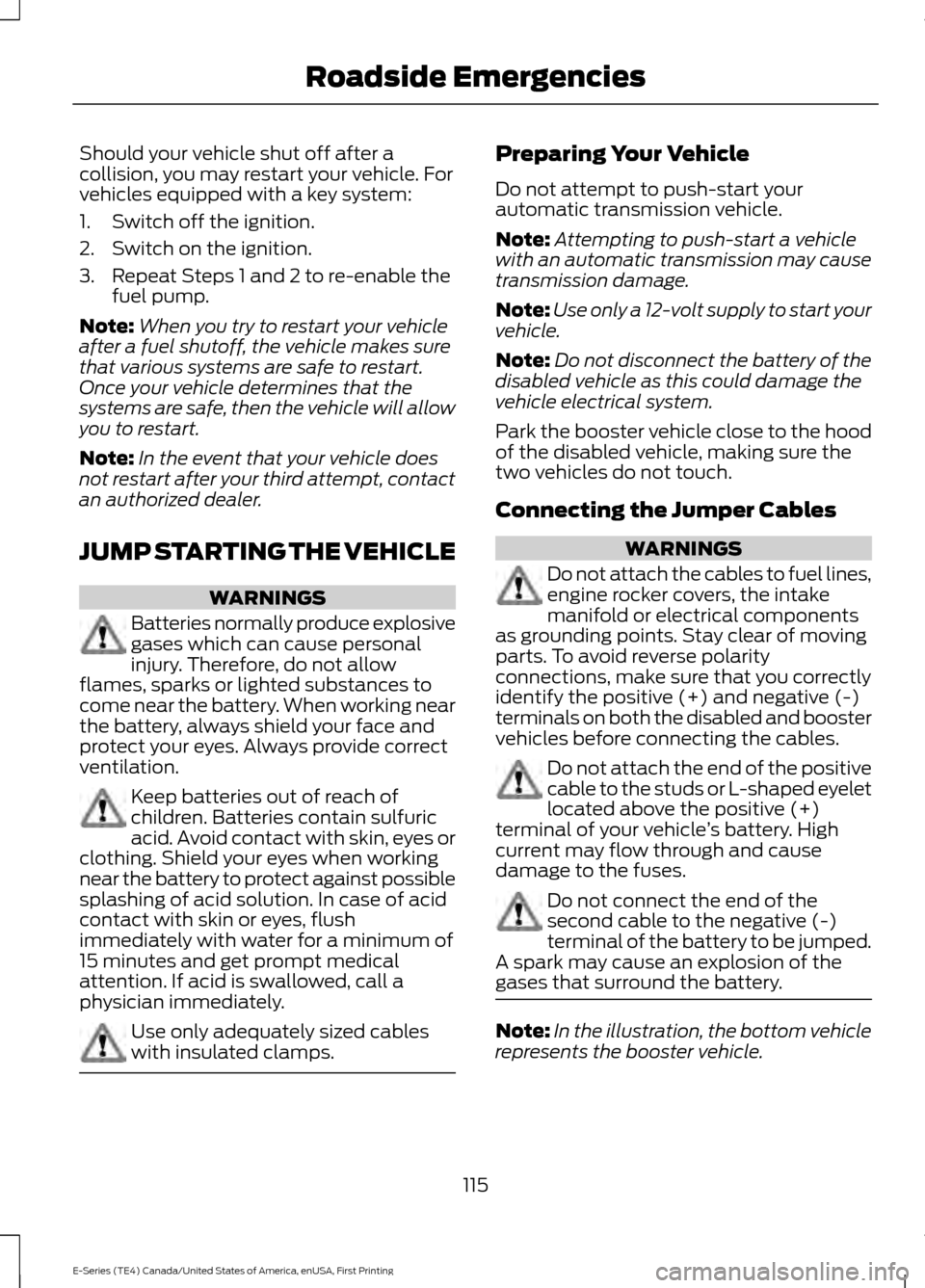
Should your vehicle shut off after a
collision, you may restart your vehicle. For
vehicles equipped with a key system:
1. Switch off the ignition.
2. Switch on the ignition.
3. Repeat Steps 1 and 2 to re-enable the
fuel pump.
Note: When you try to restart your vehicle
after a fuel shutoff, the vehicle makes sure
that various systems are safe to restart.
Once your vehicle determines that the
systems are safe, then the vehicle will allow
you to restart.
Note: In the event that your vehicle does
not restart after your third attempt, contact
an authorized dealer.
JUMP STARTING THE VEHICLE WARNINGS
Batteries normally produce explosive
gases which can cause personal
injury. Therefore, do not allow
flames, sparks or lighted substances to
come near the battery. When working near
the battery, always shield your face and
protect your eyes. Always provide correct
ventilation. Keep batteries out of reach of
children. Batteries contain sulfuric
acid. Avoid contact with skin, eyes or
clothing. Shield your eyes when working
near the battery to protect against possible
splashing of acid solution. In case of acid
contact with skin or eyes, flush
immediately with water for a minimum of
15 minutes and get prompt medical
attention. If acid is swallowed, call a
physician immediately. Use only adequately sized cables
with insulated clamps. Preparing Your Vehicle
Do not attempt to push-start your
automatic transmission vehicle.
Note:
Attempting to push-start a vehicle
with an automatic transmission may cause
transmission damage.
Note: Use only a 12-volt supply to start your
vehicle.
Note: Do not disconnect the battery of the
disabled vehicle as this could damage the
vehicle electrical system.
Park the booster vehicle close to the hood
of the disabled vehicle, making sure the
two vehicles do not touch.
Connecting the Jumper Cables WARNINGS
Do not attach the cables to fuel lines,
engine rocker covers, the intake
manifold or electrical components
as grounding points. Stay clear of moving
parts. To avoid reverse polarity
connections, make sure that you correctly
identify the positive (+) and negative (-)
terminals on both the disabled and booster
vehicles before connecting the cables. Do not attach the end of the positive
cable to the studs or L-shaped eyelet
located above the positive (+)
terminal of your vehicle ’s battery. High
current may flow through and cause
damage to the fuses. Do not connect the end of the
second cable to the negative (-)
terminal of the battery to be jumped.
A spark may cause an explosion of the
gases that surround the battery. Note:
In the illustration, the bottom vehicle
represents the booster vehicle.
115
E-Series (TE4) Canada/United States of America, enUSA, First Printing Roadside Emergencies
Page 312 of 318
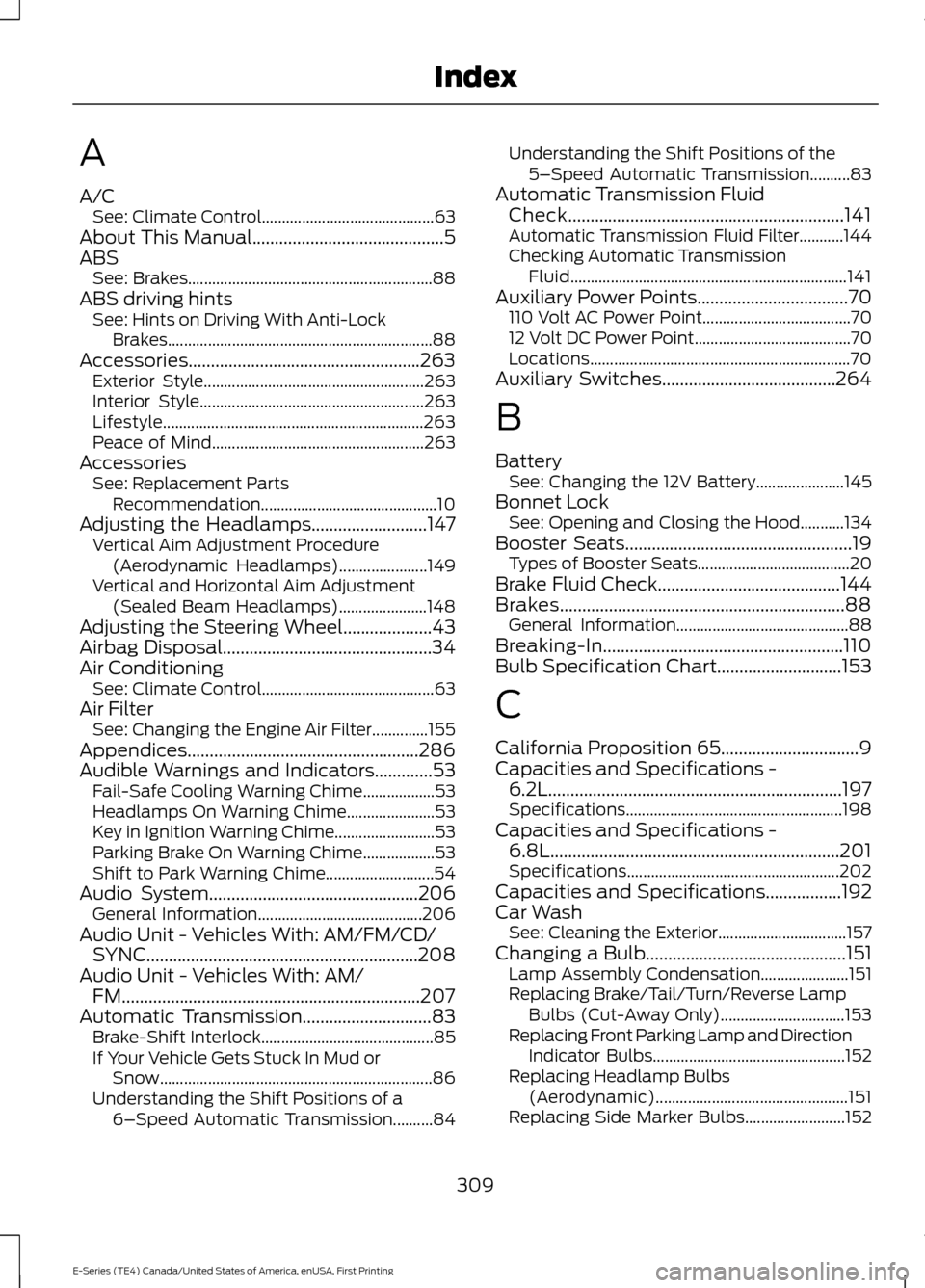
A
A/C
See: Climate Control........................................... 63
About This Manual...........................................5
ABS See: Brakes............................................................. 88
ABS driving hints See: Hints on Driving With Anti-Lock
Brakes.................................................................. 88
Accessories....................................................263 Exterior Style....................................................... 263
Interior Style........................................................ 263
Lifestyle................................................................. 263
Peace of Mind..................................................... 263
Accessories See: Replacement Parts
Recommendation............................................ 10
Adjusting the Headlamps..........................147 Vertical Aim Adjustment Procedure
(Aerodynamic Headlamps)...................... 149
Vertical and Horizontal Aim Adjustment (Sealed Beam Headlamps)...................... 148
Adjusting the Steering Wheel....................43
Airbag Disposal...............................................34
Air Conditioning See: Climate Control........................................... 63
Air Filter See: Changing the Engine Air Filter..............155
Appendices....................................................286
Audible Warnings and Indicators.............53 Fail-Safe Cooling Warning Chime.................. 53
Headlamps On Warning Chime...................... 53
Key in Ignition Warning Chime......................... 53
Parking Brake On Warning Chime.................. 53
Shift to Park Warning Chime........................... 54
Audio System...............................................206 General Information......................................... 206
Audio Unit - Vehicles With: AM/FM/CD/ SYNC.............................................................208
Audio Unit - Vehicles With: AM/ FM...................................................................207
Automatic Transmission
.............................83
Brake-Shift Interlock........................................... 85
If Your Vehicle Gets Stuck In Mud or Snow.................................................................... 86
Understanding the Shift Positions of a 6– Speed Automatic Transmission..........84 Understanding the Shift Positions of the
5– Speed Automatic Transmission..........83
Automatic Transmission Fluid Check
..............................................................141
Automatic Transmission Fluid Filter...........144
Checking Automatic Transmission
Fluid..................................................................... 141
Auxiliary Power Points
..................................70
110 Volt AC Power Point..................................... 70
12 Volt DC Power Point....................................... 70
Locations................................................................. 70
Auxiliary Switches.......................................264
B
Battery See: Changing the 12V Battery...................... 145
Bonnet Lock See: Opening and Closing the Hood...........134
Booster Seats...................................................19 Types of Booster Seats...................................... 20
Brake Fluid Check
.........................................144
Brakes................................................................88 General Information........................................... 88
Breaking-In......................................................110
Bulb Specification Chart............................153
C
California Proposition 65...............................9
Capacities and Specifications - 6.2L..................................................................197
Specifications...................................................... 198
Capacities and Specifications - 6.8L.................................................................201
Specifications..................................................... 202
Capacities and Specifications
.................192
Car Wash See: Cleaning the Exterior................................ 157
Changing a Bulb
.............................................151
Lamp Assembly Condensation...................... 151
Replacing Brake/Tail/Turn/Reverse Lamp Bulbs (Cut-Away Only)............................... 153
Replacing Front Parking Lamp and Direction Indicator Bulbs................................................ 152
Replacing Headlamp Bulbs (Aerodynamic)................................................ 151
Replacing Side Marker Bulbs......................... 152
309
E-Series (TE4) Canada/United States of America, enUSA, First Printing Index
Page 316 of 318
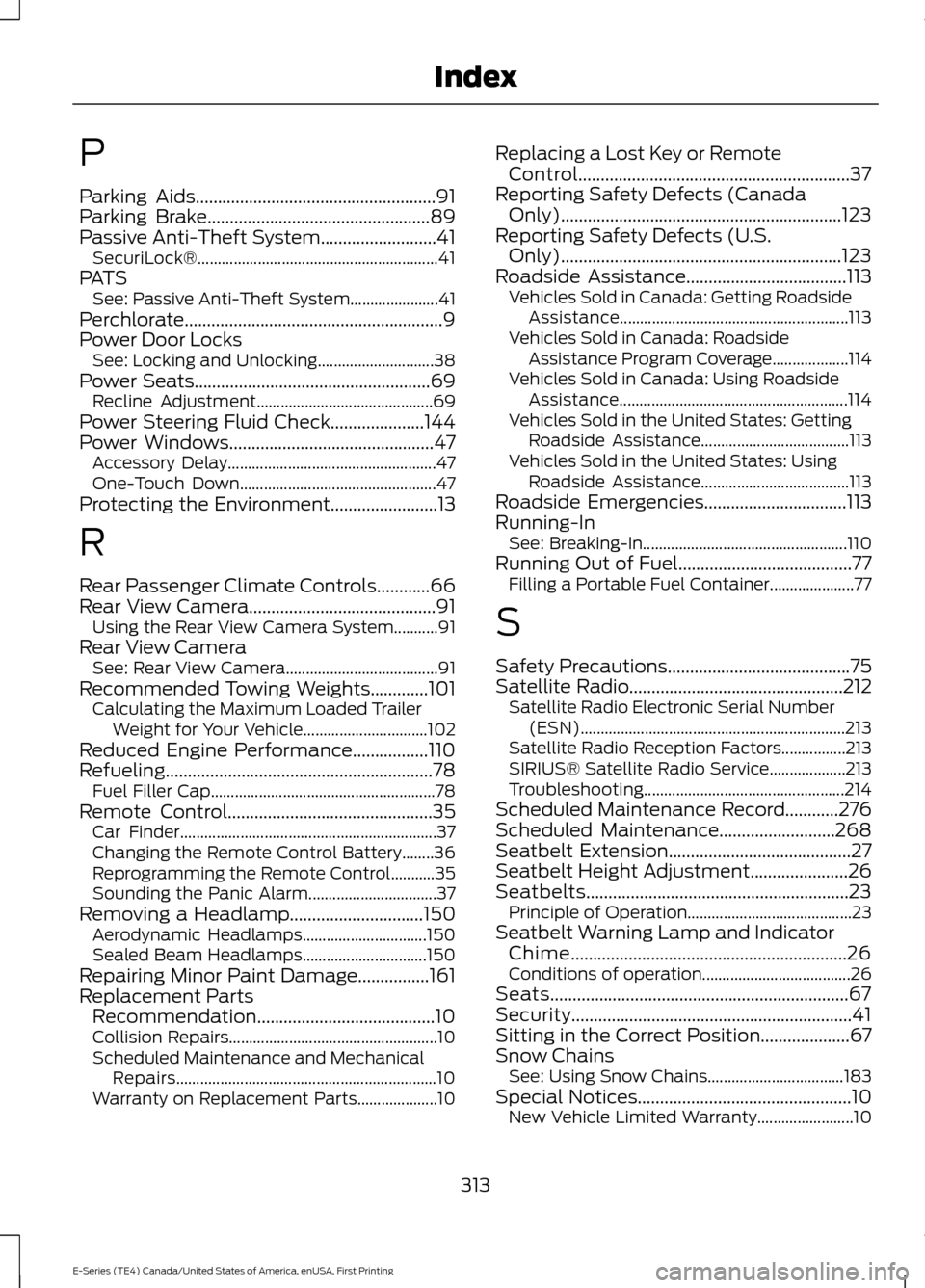
P
Parking Aids......................................................91
Parking Brake..................................................89
Passive Anti-Theft System..........................41
SecuriLock®............................................................ 41
PATS See: Passive Anti-Theft System...................... 41
Perchlorate..........................................................9
Power Door Locks See: Locking and Unlocking............................. 38
Power Seats
.....................................................69
Recline Adjustment............................................ 69
Power Steering Fluid Check.....................144
Power Windows
..............................................47
Accessory Delay.................................................... 47
One-Touch Down................................................. 47
Protecting the Environment
........................13
R
Rear Passenger Climate Controls
............66
Rear View Camera..........................................91 Using the Rear View Camera System...........91
Rear View Camera See: Rear View Camera...................................... 91
Recommended Towing Weights.............101 Calculating the Maximum Loaded Trailer
Weight for Your Vehicle............................... 102
Reduced Engine Performance.................110
Refueling............................................................78 Fuel Filler Cap........................................................ 78
Remote Control..............................................35 Car Finder................................................................ 37
Changing the Remote Control Battery........36
Reprogramming the Remote Control...........35
Sounding the Panic Alarm................................ 37
Removing a Headlamp
..............................150
Aerodynamic Headlamps............................... 150
Sealed Beam Headlamps............................... 150
Repairing Minor Paint Damage
................161
Replacement Parts Recommendation........................................10
Collision Repairs.................................................... 10
Scheduled Maintenance and Mechanical Repairs................................................................. 10
Warranty on Replacement Parts.................... 10Replacing a Lost Key or Remote
Control.............................................................37
Reporting Safety Defects (Canada Only)...............................................................123
Reporting Safety Defects (U.S. Only)...............................................................123
Roadside Assistance
....................................113
Vehicles Sold in Canada: Getting Roadside
Assistance......................................................... 113
Vehicles Sold in Canada: Roadside Assistance Program Coverage................... 114
Vehicles Sold in Canada: Using Roadside Assistance......................................................... 114
Vehicles Sold in the United States: Getting Roadside Assistance..................................... 113
Vehicles Sold in the United States: Using Roadside Assistance..................................... 113
Roadside Emergencies................................113
Running-In See: Breaking-In................................................... 110
Running Out of Fuel.......................................77 Filling a Portable Fuel Container..................... 77
S
Safety Precautions
.........................................75
Satellite Radio................................................212
Satellite Radio Electronic Serial Number
(ESN).................................................................. 213
Satellite Radio Reception Factors................213
SIRIUS® Satellite Radio Service................... 213
Troubleshooting.................................................. 214
Scheduled Maintenance Record............276
Scheduled Maintenance..........................268
Seatbelt Extension.........................................27
Seatbelt Height Adjustment
......................26
Seatbelts...........................................................23 Principle of Operation......................................... 23
Seatbelt Warning Lamp and Indicator Chime..............................................................26
Conditions of operation..................................... 26
Seats...................................................................67
Security...............................................................41
Sitting in the Correct Position
....................67
Snow Chains See: Using Snow Chains.................................. 183
Special Notices
................................................10
New Vehicle Limited Warranty........................ 10
313
E-Series (TE4) Canada/United States of America, enUSA, First Printing Index